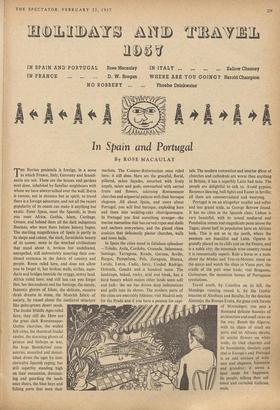IN SPAIN AND PORTUGAL Rose Macaulay IN ITALY ... Kellow
Chesney IN FRANCE ... D. W. Brogan WHERE ARE YOU GOING? HaroldChampion NO ROBBERY ... Phoebe Drinkwater
In Spain and Portugal
By ROSE MACAULAY markets. The Counter-Reformation once ruled here; it still does. Here are the graceful, florid, pillared, ochre facades, enturbed with lively angels, saints and gods, enwreathed with carved fruits and flowers, adorning Romanesque churches and seignorial palaces with their baroque elegance. All about Spain, and more about Portugal, you will find baroque, exploding here and there into wedding-cake churrigueresque. In Portugal you find something stranger—the marine manueline that has carved ropes and shells and anchors everywhere, and the glazed china azulejos that deliciously plaster churches, • walls and town halls.
In Spain the cities stand in fabulous splendour —Toledo, Avila, Cordoba, Granada, Salamanca, Santiago, Tarragona, Ronda, Gerona, Seville, Burgos, Pampeluna, Pals, Zaragoza, Huesca, Lerida, Lorca, Cadiz, Jerez, Ciudad Rodrigo, Orihuela, Guadix and a hundred more. The landscape, baked, rocky, arid and bleak, has a hard beauty which makes other lands seem soft and lush : the sea has driven deep indentations and gulfs into its shores. The modern parts of the cities are execrably hideous; visit Madrid only for the Prado and if you have a passion for capi- tals. The modern restoration and interior ddcor of churches and cathedrals are worse than anything in Britain; it has a superbly Latin bad taste. The people are delightful to talk to. Avoid gypsies, flamenco dancing, bull-fights and Easter in Seville; all these are commercialised and wearying.
Portugal is on an altogether smaller and softer and less grand scale, as George Borrow found. It has no cities in the Spanish class; Lisbon is very beautiful, with its mixed mediaeval and Pombaline streets and magnificent poise above the Tagus; about half its population have an African look. This is not so in the north, where the peasants are beautiful and Latin. Oporto is grandly placed on its cliffs and on the Douro, and is a noble city; the mountain wine country round it is romantically superb. Ride a horse or a mule about the Minho and Tras-os-Montes; stand on the quays and watch the ships in Viana port, the cradle of the port wine trade; visit Braganza, Guimaraes, the mountain homes of Portuguese revolutions.
Travel south, by Coimbra on its hill, the Mondego running round it, by the Gothic beauties of Alcobaca and Batalha, by the desolate Alemtejo, the Roman Evora, the great cork forests of Montalegre; you pass a thousand delicate beauties of architecture and small cities on the way. Reach the Algarve, with its chain of small sea ports and its African shrubs, its scarlet flowers on white walls, its tiled churches and its formidable, desolate cape that is Europe's end. Portugal is an odd mixture of wild- ness and elegance, bijouterie and grandeur; it seems a land made for happiness. Its people, talking their sof- tened and curtailed Galician, smile.










































 Previous page
Previous page